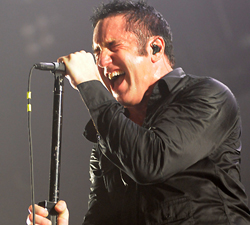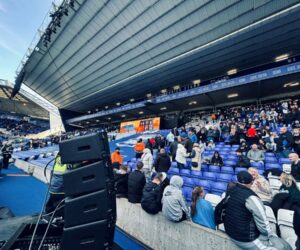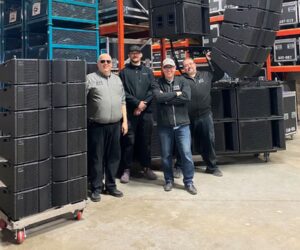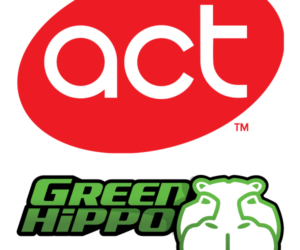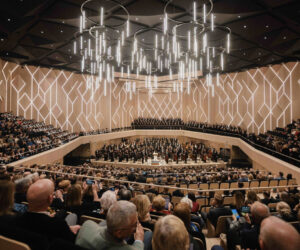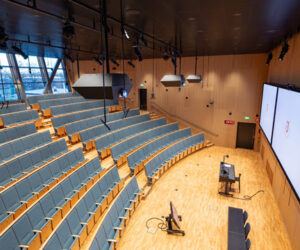Trent Reznor of Nine Inch Nails has long been known for his penchant for cutting edge technology and pristine production values. While manifestations of this tendency have been apparent since the band’s early studio recordings, over the years they have noticeably transcended into NIN’s live shows, most recently for the “Lights In The Sky” concert tour.
One of the technological advances on display, besides a stage-width, triple layered interactive LED video screen, was L-Acoustics new K1 line array. The system has been touring with various acts since its maiden voyage earlier in 2008, on Radiohead’s summer tour, as part of a testing process that L-Acoustics is doing with Firehouse Productions (owned by Bryan Olson) out of New York to demo the rig under real world operating conditions.
The L-Acoustics K1 and Kudo rig being used for the NIN tour is comprised of 12 K1s (14 for larger venues and 10 for smaller) with an accompanying 8 K1SBs flown per side. In addition, 6 SB28s sit at each corner on the floor in front of the stage with an extra pair on each side of downstage center.
The SB28s have DV-Doscs seated on top for front fill. Although there was initially talk of a proper cluster for center fill, it was scrapped due to a lack of appropriately located truss. Firehouse Productions has also provided 18 Kudos loudspeakers for 9-a-side flown side-fill to pick up where the horizontal angle of the K1 array stops.
The K1/Kudo system is designed for stadium-type venues, with the existing Kudo as a flexible compliment to the main line array. One of the main goals behind the K1 design was to reduce the number of acoustic sources needed in the line array. In terms of raw horsepower, a single K1 box produces 3 dB (SPL) more than an L-Acoustics’ V-DOSC.
The K1 features an extra HF driver (three in all) and the mid-range drivers are now flush mounted and no longer fire into one another as part of the wave guide. The K1SB features two 15-inch drivers and was designed to be flown beside the K1 array. It has an increased LF throw capacity over the existing SB28 and has relegated the SB28’s role to reproducing strictly infra bass material.
Before the new rig went out on tour, L-Acoustics’ Florent Bernard came out to spend some time going over the K1/KUDO system with the NIN audio crew. It was made clear from the beginning that one of the things L-Acoustics wanted was to receive frequent updates from real-world users.
One of the crew members instrumental in implementing this is System Tech Jamie Pollock. “We’ve been experimenting and giving them the feedback they’re looking for. All the presets are locked right now so they want to know what they need to adjust,” noted Pollock, referring to the ‘plug-and-play’ philosophy of the LA8 amplifiers associated with the new system.
The results of the K1 design had Front-Of-House Engineer Pete Keppler raving from day one: “It has one again raised the bar. V-DOSC was pretty much the industry standard for a really amazing sounding PA system. This is just taking it up a notch.”
Some of the more practical design features of the K1/KUDO system have also been receiving accolades from the audio crew. The rigging improvements have also improved on what was is used to fly a V-DOSC array.
While V-DOSC rlies on cumbersome ratchet angle-straps, the K1 uses a pin system that allows all box angles to be set while the array is sitting flat. As the array lifts, the boxes lock into place. The NIN crew boasts they can get one side of the line array up in about 10 minutes.
With the rig flown, Pollock and Keppler do their daily system tweaking. Part the process includes playing back recorded concert audio and walking around the venue. They compare what they are hearing with a Smaart Live display and make the necessary adjustments with Dolby Lake processing.
Although the LA8 amplifiers used for the main rig do feature extensive DSP control via the LA network manager, Pollock prefers to use Dolby Lake for the job: “It has the whole tablet control that I’m used to using and the hippest interface out there right now.” Pollock does use the LA8 network manger to remotely control the basic functions of the amps located under the main stage.
Monitor Engineer Mike Prowda’s pre-show routine includes the increasingly difficult search for RF space for his in-ear system. He uses a palm pilot scanner to find what he needs. If he can’t find appropriate frequencies in the G2 presets, he resorts to Sennheiser’s SIFM inter-mod calculator software.
One issue Prowda discovered his scanner can’t help him with is the seemingly random interference caused by the giant on-stage LED video screens. The keyboard player’s mix has posed the biggest RF issue as he stands closest to the video wall and furthest from the main RF transmitting antenna.
Although Prowda’s addition of an extra antenna stage-right has improved the interference issue, it still exists. To help keep an eye on this and other potential RF problems, Prowda uses Sennheiser’s Net1 system to visually monitor all his radios.
One of the only pieces of outboard audio gear used on the entire “Lights In The Sky” tour is the Apex Dominator II. Prowda uses these for final brick wall limiting before his monitor mixes hit the RF transmitters. “It’s a true radio station device. They use them in radio stations to fully modulate. I’ve got the threshold cranked up on the things because I’m driving my board like you would master something. What’s coming from the board is tickling the Dominators. If I turned those Dominators off, all those radios would be in the red. It also kind of finishes the mix.”
The on-stage layout is pretty bereft of wedges, the only ones being for the keyboardist and drummer. What’s in the keyboardist’s wedge mirrors his in-ear mix is, and the drummer gets a pre-determined mix with just acoustic and electronic drums coming out of a wedge and a DVsub. There are also L-Acoustic DVsubs at each side of the stage firing in at the guitar and bass players, just to round out their in-ear mixes with what Prowda calls ‘a little thump.’
This is not the first tour that has witnessed the audio tandem of Keppler and Prowda. They worked together for several years with David Bowie before Trent Reznor came knocking. Reznor, a long-time Bowie fan, had heard the duo’s work at a Bowie show and was convinced these were the sound guys he wanted.
Although Prowda had previously worked indirectly with the band on the 1995 “Dissonance” NIN/Bowie tour, his tenure with NIN started in at the beginning of the With Teeth album in 2005. Keppler came on board in April of 2006.
For the current tour, Prowda was brought into the fold relatively early. For a tour that opened in late July 2008, he was already in rehearsals in L.A. in early May. By the time Keppler was on the scene, full production mode had started. Both audio engineers appreciated the long rehearsal period. For Prowda, “It was intense. In a lot of other situations audio is there but we’re kind of transparent. This gig is different.”


